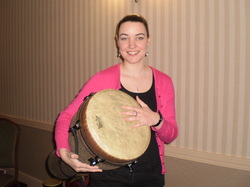
The drum is made up of a long cylinder with a metal coil at the bottom that that when it is shaken produces a thunderous sound with the vibrations from the coil flowing through the cylinder.
Activity
The activity I'm going to share with you is using a song that my good friend and fellow music therapist Laura Micheli MT-BC shared with me. A good activity is to sing the song with your client and allow them to play the thunder drum when they hear the words thunder or stormy. If the child is unable to do this you can play the thunder drum gently near them to allow them to feel or hear the vibrations. The song which is chant like along with the thunder drum can often help calm agitation. Depending on the client it is a good activity to include vocal improvisation keeping the chant like structure and matching or mirroring any of the vocal sounds or thunder drum sounds the child uses. I also like to use this chant singing the melody to la or ba and imporvising around it vocally and using a rainbow coloured organza material sheet. Sometimes the client likes to hold the material with me and lift it up and down or lie under it and I wave it up and down and improvise around the melody .
| i_hear_the_thunder_1.m4a |


 RSS Feed
RSS Feed
